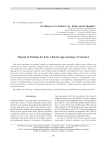Paleoenvironment, the stone age. Рубрика в журнале - Archaeology, Ethnology & Anthropology of Eurasia

Levantine Middle Pleistocene blade industries
Статья научная
The origin of Near Eastern Middle Pleistocene blade industries is discussed with reference to the Levallois reduction-technique. Special attention is paid to the Gesher Benot Ya'akov site, in Israel, where the Levallois technology is the earliest in the region (ca 800 ka BP). Whereas later Acheulean industries show no continuity with the Levallois tradition, the alternation of predominant Middle Pleistocene technologies indicates changing adaptation strategies caused by ecological conditions. Accordingly, the early appearance of the laminar technology in the Near East evidences local evolution rather than immigration. The major factors underlying this innovation were adaptation and the intrin sic development of the Levallois system. Laminar technologies, which are fi rst evidenced by certain Levantine sites even earlier than Gesher Benot Ya'akov, became widely distributed at the Acheulo-Yabrudian stage of the late Acheulean. A well-developed blade technology is demonstrated by the Amudian industry of Qesem, Israel, dating to 400–200 ka BP.
Бесплатно

Materials from dwelling 2 on Suchu island, the Lower Amur (1977 season, excavation III)
Статья
This article presents the fi nal results of excavations at one of the largest Neolithic sites in northeastern Asia— a settlement on Suchu Island on the Amur. Most of the rich collection (3967 spec.), owned by IAET SB RAS (stone tools, ceramics, ornaments, and artistic and ritual artifacts), has not been described before. This publication focuses on the analysis of artifacts from dwelling 2 (excavation III, 1977). We describe the construction of this semi-underground dwelling, circular in plan view. The typological analysis of the lithics indicates a complex economy. Many of them (arrowheads, projectile points, inserts, knives, plummets) relate to hunting and fi shing, and to processing carcasses (end-scrapers, scrapers, burins, combination tools), others are chopping tools. The distinctive feature of the lithics is that some are bifacial. The analysis of the ceramics suggests that they belong to the Late Neolithic Voznesenovskoye culture. The use of binocular microscopy allowed us to assess the technological and constructive properties of the ceramics, as well as their morphological, decorative, and functional features. Non-ut ilitarian artifacts shed light on the worldview of the Suchu people. The collection dates to the mid-second millennium BC.
Бесплатно

Middle paleolithic bone retouchers: size or proportions
Статья
Bone retouchers are the most common tools for processing lithic raw material in the Middle Paleolithic of Eurasia. Typically, they are perceived by Paleolithic researchers as informal, unmodifi ed tools made from bone blanks accidentally obtained during the extraction of marrow. In this article, we introduce new data on a large collection of bone retouchers from Chagyrskaya Cave (in the Altai Mountains). Their dimensions demonstrate a high standardization of blanks, indicating the intentional selectivity of Neanderthals. Selection also concerned animal species and the anatomical positions of bones. We found that morphological characteristics such as the number of active areas and the degree of their modifi cation did not affect the size of the retouchers and attest only to the reorientation of tools during lithic processing. In the course of retouching, cross-sections of diagnostic traces in the active areas underwent signifi cant changes: whereas at the early stages they reveal “furrows” with V-shaped cross-sections, multiple blows against the processed lithic resulted in the deformation of the original form, which eventually resembled an upturned trapeze. The comparison of bone retouchers from several multicultural Middle Paleolithic complexes in Eurasia (Chagyrskaya and Denisova caves in the Altai, Kabazi V site in the Crimea, and Barakayevskaya Cave in the Caucasus) evidences similar proportions but considerable variation in size. Proportions, then, are an inherent functional characteristic of bone retouchers, which does not depend on either the cultural context or the raw material base.
Бесплатно

Multidisciplinary study of burnt deposits at Surungur, Fergana valley, Southern Kyrgyzstan
Статья
Бесплатно

New data on the chronology of the initial Neolithic Gromatukha culture, Western Amur region
Статья обзорная
Бесплатно

New dental finds associated with the Paleolithic Selenga culture, Western Trans-Baikal region
Статья
Бесплатно

Novopetrovka III-an early neolithic site in the Western Amur basin and its chronology
Статья
This article discusses the chronology of Novopetrovka III—a Neolithic settlement in the Western Amur basin, evaluated by the radiocarbon analysis of charred remains on pottery. The Novopetrovka culture as a whole, represented by Novopetrovka I–III and Konstantinovka sites, which had been excavated in the early 1960s, was dated to the 5th (possibly 6th) to early 4th millennia BC on the basis of the typology of the blade industry. The overview of data on prismatic blades manufactured by the pressure technique demonstrated that blade industries appeared in a vast territory of Eurasia in the Final Pleistocene to Early Holocene and, in certain regions, survived until the Chalcolithic. Therefore, they are only a rough guide to the relative chronology of the sites. In the 1990s, after the appearance of radiocarbon dates generated from samples of organic remains in temper and charred remains on pottery from Novopetrovka II, the culture was redated to 15.5–10.8 cal BP. A comparative analysis of new radiocarbon dates based on charred remains on pottery suggests that the age of Novopetrovka III is 9.0–9.5 thousand years. Because no changes were traced in the Novopetrovka sites over a long period of time, the chronological assessment of the Novopetrovka culture in toto and of its separate sites is problematic.
Бесплатно

Oldowan or pebble-flake industry? Levantine Mousterian or Levantine middle Paleolithic?
Статья научная
The emergence of Levallois technique and the origin of the Levantine Middle Paleolithic, addressed in my previous publication, are revisited. In the fi nal Acheulean of the Levant, the Acheulo-Yabrudian industry emerged and the blade technology was invented. On that base, the Levantine Middle Paleolithic originated. The terms “Oldowan industry” and “Levantine Mousterian” should be abandoned. The Oldowan industry was associated with Homo habilis, who had never migrated outside Africa. Because early Middle Paleolithic industries originated from the Acheulo-Yabrudian industry of the Levant, they should be referred to as Middle Paleolithic rather than Mousterian. The Mousterian was associated with H. neanderthalensis, whereas the industries of territories where Neanderthals had not migrated should be referred to as Middle Paleolithic. Neanderthal migrations resulted in the emergence of Mousteroid industries in Eastern Europe, Caucasus, Crimea, southern Siberia, etc. In Africa, a new taxon Homo heidelbergensis (H. rhodesiensis) originated ca 800 ka BP. Eventually, those humans migrated to the Near East, as evidenced by the Gesher Benot Ya'aqov site. Throughout the Middle Pleistocene, Near Eastern, primarily Levantine populations were involved in the sapienization process. By the early Upper Pleistocene, two sister taxa had apparently originated there: anatomically modern humans (Skhul, Qafzeh) and Palestinian Neanderthals (Tabun, Amud, Kebara). There was no radical change in Acheulean or Middle Paleolithic industries in the Levant that might suggest immigration from Africa or the adjacent territories of Eurasia. Anatomically modern humans associated with the Nubian Levallois industry migrated from Africa to Arabia ca 110 ka ago. They may have had short-term contacts with Levantine Middle Paleolithic populations, but archaeological evidence of acculturation is lacking.
Бесплатно

On the date of the Great Shigir idol
Статья научная
The Great Shigir Idol is the largest anthropomorphic wooden sculpture in the world, a unique work of Stone Age art, and a valuable source for reconstructing the material culture and worldview of the ancient population of Northern Eurasia. Although study of it began more than 100 years ago, a number of issues, such as the place of discovery, context, date, methods of exhibition, etc., remain controversial. This article analyses archival documents relevant to the location and time of discovery of the Great Shigir Idol, and on the accompanying finds. The results of a recent comprehensive study conducted by Russian and German archaeologists and scientists in 2014 are outlined. The focus is on the analysis of AMS radiocarbon dates, spanning a period from the Late Pleistocene (~10,500 cal BC) to the Late Mesolithic/Early Neolithic (~6000 cal BC). These dates show a considerable range of variation, and they disagree with those derived from the conventional radiocarbon dating in 1997. Paleogeographic and archaeological data from the Trans-Urals do not support the early (9600–9000 cal BC) estimates of the time of the idol’s creation, but rather correspond to later ones, derived from the AMS 14C analysis conducted in 2014. Therefore, it is necessary to continue the study of Mesolithic sites and paleoclimate of the Urals, determine the nature of primary peat formation at the Ural peatlands, and assess their age and that of the microremains of peat in early cracks in the idol, etc.
Бесплатно

Peculiarities of using 2D electrical resistivity tomography in caves
Статья
The effi cienc y of archaeological studies inside caves could be greatly enhanced by geophysical methods because of their potential for examining deposit structure and features. Application of those methods in caves entails a number of problems caused by limited space for measurements and the complexity of the surrounding medium’s structure as compared to above-ground measurements. In 2017, Selungur Cave in the Fergana Valley, Kyrgyzstan, was examined using electrical resistivity tomography. Because of the above concerns, in the course of the work the question of the reliability of the results arose. To clarify the issue, a numerical experiment was performed to assess the effect of the three-dimensional cave geometry on the results of a two-dimensional inversion. It was found that variations of cave geometry parameters result in unexpected false anomalies, and considerable errors in bedrock location and resistivity can occur. In the case of downward diverging cave walls, an accurate resistivity section can be obtained by using the inversion based on a two-dimensional model. Therefore, electrical resistivity tomography in caves with similar geometry can yield reliable resu lts concerning the shape of bedrock surface, the thickness of sedimentary layers, and size and position of inclusions such as fallen fragments of roof therein.
Бесплатно

Percussive-abrasive stone tools from Chagyrskaya cave: results of functional analysis
Статья научная
This article presents a comprehensive study of percussive-abrasive active stone tools from Chagyrskaya Cave, using experimental use-wear and statistical methods, supplemented by 3D-modeling. Experiments combined with use- wear analysis allowed us to determine the functions of these tools by comparing the working surfaces and use-wear traces in the Chagyrskaya samples with those in the reference samples. As a result, we identified 19 retouchers, four hammerstones for processing mineral raw materials, and one hammer for splitting bone, which indicates the dominance of secondary processing over primary knapping in the Chagyrskaya lithic assemblage. Using statistical analysis, we traced the differences in the dimensions of the manuports and lithics under study. These artifacts are a promising and underestimated source of information for identifying working operations associated with stone- and bone-processing; moreover, they can provide new data on the functional attribution of sites and the mobility of early hominins.
Бесплатно










